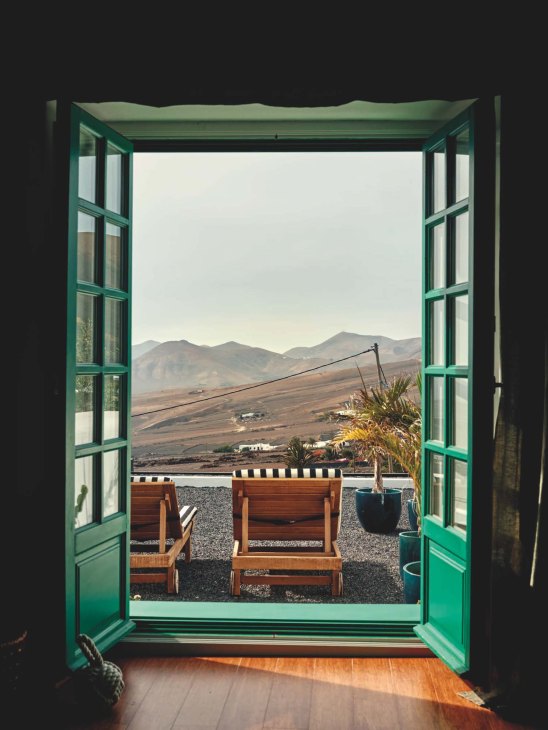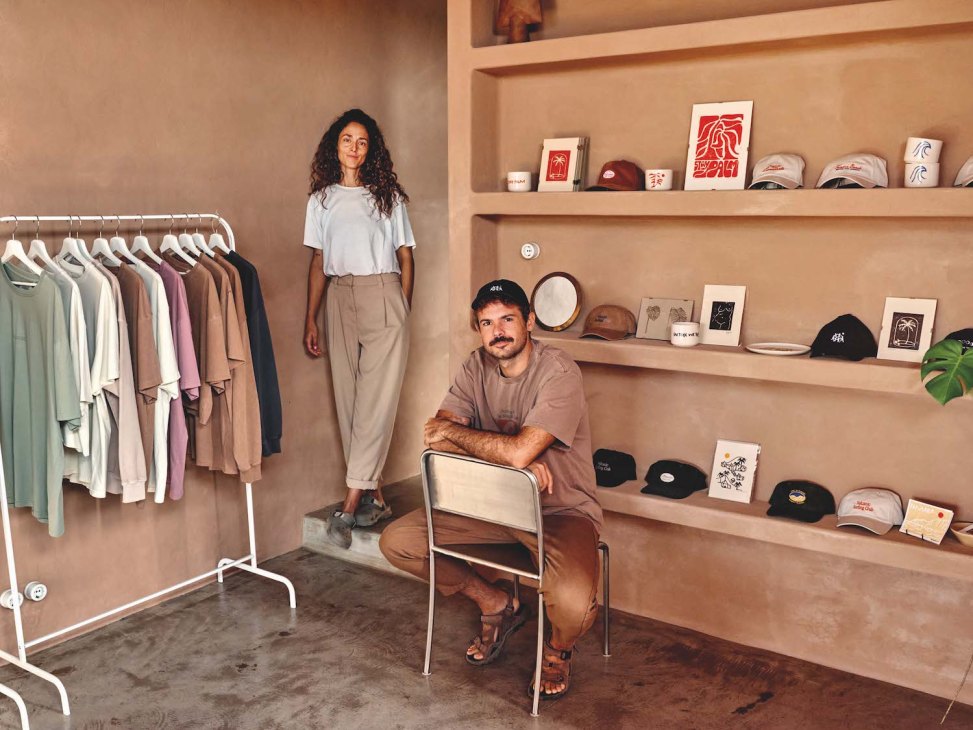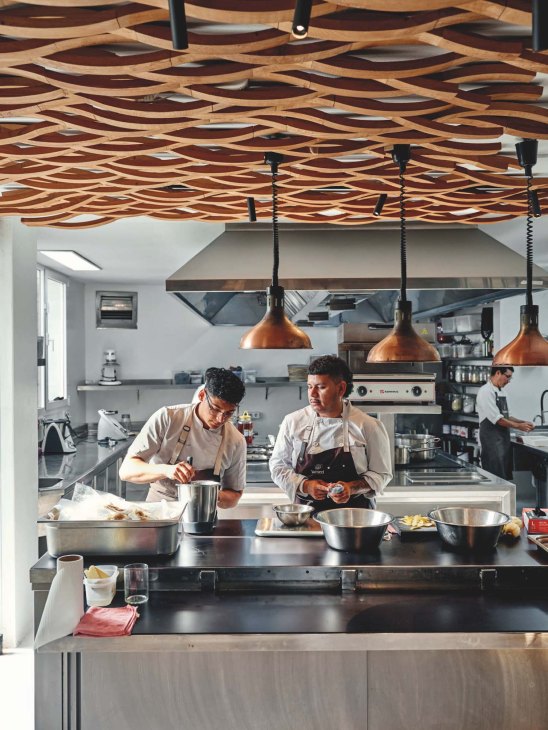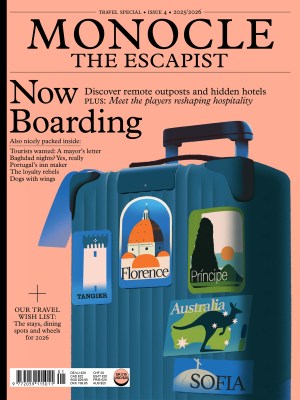Fertile ground: Lanzarote’s business boom
On the eastern edge of the Canary Islands, Lanzarote’s hospitality scene is proving that there’s value in championing creativity. We meet the entrepreneurs firing up this volcanic outpost.

Lanzarote is known as the “island of 1,000 volcanoes” and its dramatic landscapes are vivid reminders of nature’s power. “Don’t worry – only one of the volcanoes is considered active,” says longtime resident Adrián Nicolás von Boettinger, as he leads Monocle through Lagomar, an architectural marvel built into an old rock quarry. At first glance, Lagomar’s façade barely registers as part of a building. The semi-subterranean structure features rooms, tunnels and terraces; only the balconies, stairs and footbridges, which cut into the rock surface, offer a sense of structure, while looking like beads of icing flowing down the side of an uneven cake.
Lagomar encapsulates how Lanzarote, the easternmost of the Canary Islands, has grabbed the design world’s attention since the 1960s with its idiosyncratic combination of oddity and invention. Its lava-hewn landscapes are arresting spectacles that can help to unlock architects’ imaginations; the inhospitable landscape, however, also prompts sobering civic discussions. The island has long been grappling with questions of how to live within its limitations and make the most of tourism without being overwhelmed.
With his sister, Tatyana, Von Boettinger took over the Lagomar property from their parents, architects from Germany and Uruguay, who bought the cliffside home in a state of disrepair in 1989. “There was so much mystique surrounding the building that they put down a deposit for it without even stepping inside,” says Tatyana, who adds that it was once home to Egyptian film star Omar Sharif.

After a gun-toting squatter was politely paid to leave the premises, the site underwent several years of structural improvements. In 1997 the house finally reopened as an architectural museum; more recently it was renovated as a restaurant, bar and music venue (plans for an artist’s residency are also in the works). It’s a microcosm of the island’s identity crisis: a vision for the future that’s firmly anchored to the past.
Lagomar is unique but in some ways it isn’t alone. Since the 1960s the island has walked a tourism tightrope in order to transform an agrarian society into a modern one, while trying to balance economic and ecological sustainability. From the 1960s to the late 1980s, artist and sculptor César Manrique was the island’s visionary-in-chief and, in effect, its architectural art director. Aghast by the postwar construction boom on neighbouring islands Tenerife and Gran Canaria, Manrique championed an ethos for Lanzarote that honoured the landscape, preserved tradition and resisted harmful development. He also designed scores of the traditionally inspired structures hewn into the island’s almost extra-terrestrial looking rocks.


Manrique’s less-is-more vision often sat uncomfortably with the island’s financial and political ambitions. The tourism sector, in particular, bridled at the idea of being constrained by an artist’s whims. Over the years, many hotels of varying standards were built and entire coastal towns turned into holiday resorts – much to the chagrin of Manrique, who agitated for restraint until his death in 1992.
To some, the artist and sculptor’s message was nuanced and prescient; to others, however, it was plain confusing. The house where he lived between 1968 and 1988, built into a petrified lava field, is now the base of his eponymous foundation. Among its exhibits is a video of Manrique warning about the island’s existential decay and criticising various beachfront hotels, mostly in front of the kind of visitors who stay in such places. It’s unclear whether his fervent approach was persuasive or just made those listening feel unwelcome.
“It’s not tourists that people are tired of,” says restaurateur Georgia Coles. “We love them and live off them. The problem is the tired model of tourism.” Today is the soft-opening of her new venture, La Lapa, and the first-day fluster is palpable. Coles steadies the ship, keeping an eye on the hungry guests in the dining room, while telling Monocle about some of the local tensions in the front bar. “In summer the taps in some of Lanzarote’s towns run dry but then we see hotels’ water supply safeguarded,” she says. “Residents can feel like their concerns are secondary.”
This delicate balance – between local and visitors’ interests, between too many tourists and too few – is on everyone’s lips. “Lanzarote teaches you how to live with very little,” says Zoe Barceló, an art director from Alicante who started a new life here with his partner, Geo Giner, a fashion designer from Barcelona. They tell us about their previous work lives, in which demanding deadlines meant more than 10 hours of screen time a day. “This is sort of a pre-retirement,” says Giner with a grin, gesturing at his surroundings. Looking for a rental property, the couple found a run-down toolshed and perrera (a house for hunting dogs). They have transformed both into an impressively appointed modern home and studio.
“We have seen more people coming to the island looking for peace, sometimes silence,” says Giner. But life didn’t stay quiet for long for the pair, whose new landscape-inspired clothing brand, Latitud Fuego, taps into the surf culture that’s thriving in coastal towns such as Caleta de Famara. Selling pieces sourced mainly from Portugal but embroidered by a Lanzarote-based artist, they started with 200 garments, which quickly sold out. The couple also juggle consulting work with other small businesses, helping to upgrade menus, signage and merchandise. “Manrique remains an inspiration,” says Barceló. “His legacy gives the island a conscience.”

For those working Lanzarote’s crater-strewn land, Manrique-style ideas of minimal intervention are more than just theoretical, given how difficult it is to cultivate crops here. Self-taught winemakers Eamon López O’Rourke and Laura Fábregas Camacho are the married couple behind a winery called Cohombrillo. The 13-hectare site hosts bi-weekly tastings in a garage. “Our techniques help us to make do with very little,” says O’Rourke. “We try to stay attuned to the limitations and wisdom of the land. Lately, we have been getting a lot of visitors from Japan who are curious about how we cultivate the volcanic soil.” He points to a pallet loaded with 300 bottles earmarked for export to Asia, underlining what that means for business.
María José Alcántara Palop is the director of MIAC, a fort turned-modern art museum, as well as of Lanzarote’s biennale. The current edition, which runs until 30 June, features excursions around volcanoes that morph into panel discussions and performances staged inside “teleclubs” – rural bars known for bringing the first televisions to the island’s remote villages. “Lanzarote needs more artists and more spaces – to be more courageous and insistent, even in the face of resistance from a bureaucracy that’s stuck in its ways,” says Palop, who worked with Manrique when he was younger. “He taught us to be bold, to honour the island’s singularity. He envisioned Lanzarote as a beacon for creativity.”

Yves Drieghe and Bert Pieters swapped their 20 sq m rooftop garden in Belgium for a 20,000 sq m hillside farm near the town of Los Valles. They refurbished the farmhouse, transforming it into a residence for writers, painters and makers that they named Hektor. Guests are encouraged to adhere to the island’s logic. “Small is beautiful,” says Drieghe. “Nature and the locals require respect.” The farm has gradually also become a kind of animal shelter, with a donkey, a duck, two pigs, some sheep and Frits the dog wandering the grounds.
Older generations of residents have been welcoming of new arrivals, as long as they respect the island and its people. “In our case, we held up a mirror to the beauty of their community and what they did so well,” says Drieghe, pointing to farming practices that harness the soil’s mineral richness despite the paucity of rainfall. “Meanwhile, artists bring with them new visions about what the island is and what it could be.”

Prior to this, Drieghe and Pieters ran an agency overseeing big projects, a small magazine shop and a café. “It’s no wonder we were stressed,” says Pieters, laughing. They apply their new stripped down life philosophy to the artists staying in Hektor, who don’t have to submit works at the end of their residency. “We have removed all of the pressure,” says Drieghe. “The same goes for us: there’s no intention to expand.”
Lanzarote address book
Stay
The Martínez family turned the estate of César Manrique’s grandfather into the 20-key César Lanzarote hotel, operated by the Annua Signature group. There’s also Casa de Las Flores, Palacio ICO and Buenavista Lanzarote. Serviced residences such as Villa Tenor offer more privacy.
Eat
Kamez í was awarded the island’s first Michelin star. Its Basque founder and architect Koldo Agurren designed a row of sea-facing domed structures where guests can enjoy a drink before tucking into a dinner prepared by no fewer than 16 chefs. Other high-end restaurants, such as SeBe and La Tegala, have more of the playful flair that the Canaries are known for. La Lapa in Arrecife is a fresh take on a traditional seafood café. Further south, Bodega de Uga offers an excellent wine selection and satisfying meaty dishes.
Drink
Winemaker Cohombrillo’s tasting sessions offer more than just insights into wine and cheese: they also reveal aspects of the island’s character. Hand-picked grapes are carried down the mountain on foot. “I call our type of viticulture ‘heroic winemaking’, because it has an enhanced human touch,” says co-founder Laura Fábregas Camacho. Also visit micro-brewery and bar Cervezas Nao in Arrecife.
See
A tour of Manrique’s architectural masterpieces is essential. With architect Jesús Soto, he made fantasy a reality in standout works including Jameos Del Agua, Mirador del Río, the MIAC museum’s sea-facing restaurant and the Monumento al Campesino.
Getting your bearings
The easternmost of the Canary Islands, Lanzarote (population: 163,000) is 125km off the north coast of Africa and 1,000km south of Spain. Its capital, Arrecife, is in the south. The airport serves 84 European destinations. Taxis are fine for towns but the best way to see the island is by renting a car.


